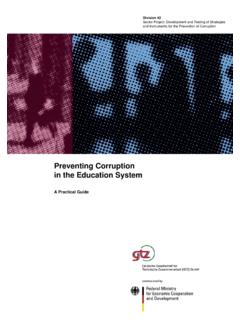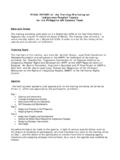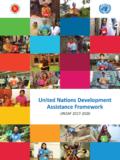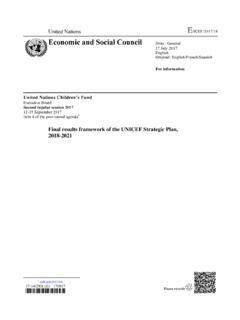Transcription of Examples of Educational Strategies to Promote ...
1 FRESH Tools for Effective School Health First Edition Examples of Educational Strategies to Promote environmental Health The information in this tool was adapted by unesco from the following publication: WHO, unesco , UNICEF, EDC, World Bank, PCD, EI, 2003. The Physical School Environment: An Essential Component of a Health-Promoting School. WHO Information Series on School Health Document 2. Geneva: WHO. Description of document: This document, which focuses on the physical environment in schools, provides guidance to assist school personnel to identify and modify aspects of the physical environment that jeopardize safety and health. It further contains guidance to ensure that positive changes in a school s physical environment are supported, reinforced and sustained by school health policy, skills-based health education and school health services, as called for in the international FRESH initiative for effective school health programming.
2 Description of tool: This tool describes the contribution that skills-based health education brings to efforts aimed at creating a health-supportive physical environment at schools or in communities. In addition, it suggests Educational themes and Strategies that could form the basis of a curriculum unit to Promote environmental health. This information or activity supports Core Component #3 of the FRESH framework for effective school health: skills-based health education. It will have a greater impact if it is reinforced by activities in the other three components of the framework. FRESH Tools for Effective School Health First Edition 1 Examples of Educational Strategies to Promote environmental Health1 I.
3 Introduction The World Health Organization estimates that between 25% and 33% of the global burden of disease can be attributed to environmental risk factors. Children, due to their reduced immunity, their immature physiology, and the fact that they are growing and developing at a rapid rate, are even more vulnerable than adults to the adverse health effects of chemical, physical and biological hazards. A majority of children throughout the world now attend primary school, which means they spend a significant amount of time within school environments during critical stages in their development. As expected, the physical environment of a school impacts the health of both its students and staff, with consequences that are not limited to the occurrence of immediate illness and disability, but also extend to the development of diseases with longer latency periods ( , cancers), and include effects on related matters such as school enrolment, attendance and learning.
4 Potential risks at school include unsafe water and sanitation, contaminated indoor and outdoor air; unsafe building structures; vector-borne diseases such as malaria, yellow fever and dengue fever; excessive exposure to ultraviolet radiation from the sun; and facilities that are contaminated with asbestos, organic solvents, bacteria and toxic metals such as lead and arsenic. All members of the school community need clean air to breathe, clean water to drink, a safe place for recreation, a safe way to travel to school, and protection from extreme temperatures and ultraviolet radiation. A safe and healthy physical environment requires a good location and safe buildings; protection from excessive noise; natural light; appropriate water and sanitation facilities; clean indoor air; a healthy outdoor environment; and healthy school-related activities including safe management and maintenance practices, use of non-toxic cleaning supplies, careful use of pesticides, vector control, and use of non-toxic art supplies.
5 Though some matters of environmental health must be decided, managed and enforced by authorities at the highest levels of government, an informed and motivated group of school/community members can achieve a great deal, at little or no cost, at the local school level. Education plays a key role in efforts to mobilize participation in effective and sustainable action to protect and improve the physical environment of a particular school. II. The role of skills-based health education Much can (and often must) be done to improve physical structures and conditions at the school (see Creating a Healthy School Environment), however, physical changes alone will not suffice to create a health-supportive physical environment at schools or in communities.
6 Students, and the adults they will soon become, will need to acquire knowledge, attitudes, values and skills to sustain improvements and address new challenges in the environment. Skills-based health education, along with school health policies, school health services and a health-supportive school environment are considered the basic components of an effective school health programme. Actions taken in these four key areas complement and reinforce each other. FRESH Tools for Effective School Health First Edition 2 Skills-based health education to Promote environmental health should: increase awareness of environmental threats to health, generate a feeling of responsibility for health and the environment, inform students about how to avoid health risks and how to create an environment that is conducive to healthy living, be designed to contribute to improvements in the physical school environment including the school site and buildings, indoor and outdoor air quality, and school-related activities affecting the environmental quality of schools, improve the health of students.
7 Collaboration between education and health officials, the school health team, the community advisory committee and other school and community members is necessary to identify the knowledge, attitudes, behaviours, skills and services students need to acquire to protect themselves from illness and hazards associated with the physical environment at school or in their communities, and to help improve environmental conditions that affect health. Educational Strategies and materials for environmental health-related issues are available through some governmental and non-governmental agencies and organizations, universities, and teachers unions. Supplemental materials specific to the local environment can be generated by teachers in collaboration with health officials, the school health team, the community advisory committee and other school and community members who can help identify the physical environmental conditions that affect children s health in the community.
8 III. Examples of Educational Strategies to Promote environmental health The topical issues and learning activities suggested below could form the basis for a unit dealing with environmental health within the overall health education curriculum. Or, where health is not a separate course of study, they could be adapted to fit within other disciplines ( , history, science, mathematics, geography, social studies, literature, art, etc.) at various grade levels. environmental health Explain how specific illnesses are related to poor environmental quality. Identify key environmental threats to health within your school and community. Older students could compare threats among different regions of their country, or among different countries around the world.
9 Air Identify possible sources of indoor air pollution. Identify sources of air pollution within schools ( , wood smoke cooking fumes, pesticides, and volatile chemicals.) Discuss practical options to improve air quality within the school. FRESH Tools for Effective School Health First Edition 3 Identify sources of air pollution within the community ( , motor vehicles, industrial activity, construction equipment, and agricultural practices.) Consider how pollution levels might be reduced, or how exposure may be minimized. Explore how pollution may vary by time of day. Research whether indoor air is cleaner than outdoor air, and the implications for ventilation. Keep track of rates of respiratory illness within the school through the year.
10 Use this as an opportunity to teach mathematics and graphing of data. Water Identify sources of water in the community. Identify contaminants that may threaten the local water supply. Explore how land use practices may affect water quality in your community. Discuss ways to keep the water supply safe from dirt, bacteria, parasites, or other contaminants that could make the water supply unhealthy. Explore ways of promoting safe water storage and disinfection practices in the home. Research how human illness may be related to water pollution. Have older students design a water quality sampling strategy that would capture different types of pollution, and its variability throughout the year.












